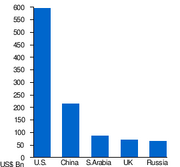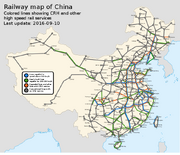China is the world's most populous state, with a population of over 1.381 billion.[15] The state is governed by the Communist Party of China based in the capital of Beijing.[16] It exercises jurisdiction over 22 provinces, five autonomous regions, four direct-controlled municipalities (Beijing, Tianjin, Shanghai, andChongqing), two mostly self-governing special administrative regions (Hong Kong and Macau), and claims sovereignty over Taiwan.

Country foreign exchange plus gold minus external debt
, it is the world's second-largest economy by nominal GDP and largest by purchasing power parity (PPP). China is also the world's largest exporter and second-largest importer of goods.[22]

nuclear weapons stateand has the world's largest standing army and second-largest defense budget.[23][24]

Distribution of supercomputers in the world
China is rapidly developing its education system with an emphasis on science, mathematics and engineering; in 2009, it produced over 10,000 Ph.D. engineering graduates, and as many as 500,000 BSc graduates, more than any other country.[345] China is also the world's second-largest publisher of scientific papers
, producing 121,500 in 2010 alone, including 5,200 in
[346]Chinese technology companies such as Huawei and Lenovo have become world leaders in telecommunications and personal computing,[347][348][349] and Chinese supercomputers are consistently ranked among the world's most powerful.[350][351] China is furthermore experiencing a significant growth in the use of industrial robots; from 2008 to 2011, the installation of multi-role robots in Chinese factories rose by 136 percent.[352]

Long March rocket
In 2003, China became the third country to independently send humans into space, with Yang Liwei's spaceflight aboard Shenzhou 5; as of 2015, ten Chinese nationals have journeyed into space, including two women. In 2011, China's first space station module, Tiangong-1, was launched, marking the first step in a project to assemble a large manned station by the early 2020s.[356] In 2013, China successfully landed the Chang'e 3 probe and Yutu rover onto the Moon; China plans to collect lunar soil samples by 2017.[357]
China is developing its own satellite navigation system, dubbed Beidou, which began offering commercial navigation services across Asia in 2012,[365] and is planned to offer global coverage by 2020.[366]

China's high-speed rail (HSR) system, built entirely since the early 2000s, had 11,028 kilometers (6,852 miles) of track in 2013 and was the longest HSR network in the world.[376] The network includes the Beijing–Guangzhou–Shenzhen High-Speed Railway, the single longest HSR line in the world, and the Beijing–Shanghai High-Speed Railway, which has three of longest railroad bridges in the world.[377] The HSR track network is set to reach approximately 16,000 km (9,900 mi) by 2020.[378] The Shanghai Maglev Train, which reaches 431 km/h (268 mph), is the fastest commercial train service in the world.[379]